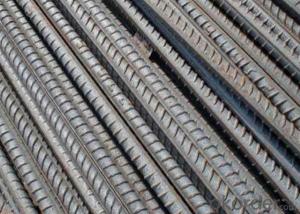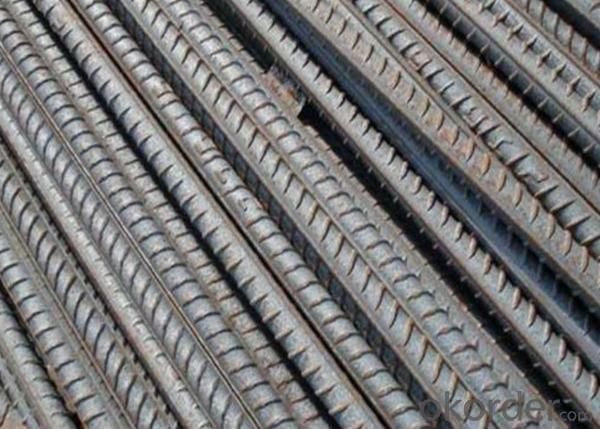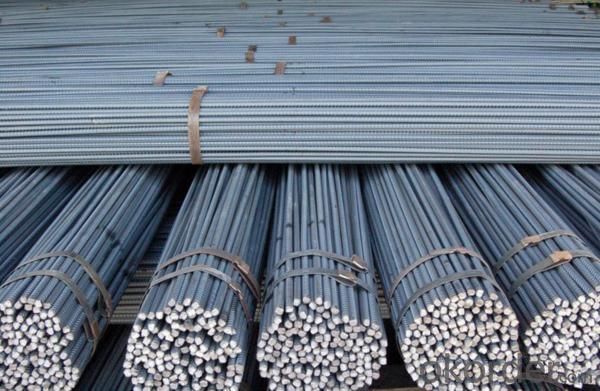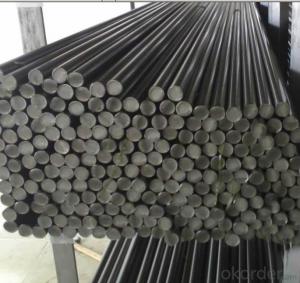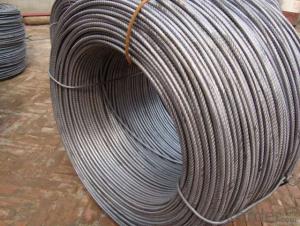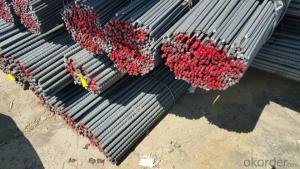Hot Rolled Steel Deformed Bar HRB400 HRB500 HRB600 for construction
- Loading Port:
- Tianjin
- Payment Terms:
- TT or LC
- Min Order Qty:
- 1000 m.t.
- Supply Capability:
- 10000 m.t./month
OKorder Service Pledge
OKorder Financial Service
You Might Also Like
Product Description:
OKorder is offering Hot Rolled Steel Deformed Bar HRB400 HRB500 HRB600 for construction at great prices with worldwide shipping. Our supplier is a world-class manufacturer of steel, with our products utilized the world over. OKorder annually supplies products to European, North American and Asian markets. We provide quotations within 24 hours of receiving an inquiry and guarantee competitive prices.
Product Applications:
Hot Rolled Steel Deformed Bar HRB400 HRB500 HRB600 for construction are ideal for structural applications and are widely used in the construction of buildings and bridges, and the manufacturing, petrochemical, and transportation industries.
Product Advantages:
OKorder's Hot Rolled Steel Deformed Bar HRB400 HRB500 HRB600 for construction are durable, strong, and resist corrosion.
Main Product Features:
· Premium quality
· Prompt delivery & seaworthy packing (30 days after receiving deposit)
· Corrosion resistance
· Can be recycled and reused
· Mill test certification
· Professional Service
· Competitive pricing
Product Specifications:
Standard | GB | HRB400 | |
Diameter | 6mm,8mm,10mm,12mm,14mm,16mm,18mm,20mm, 22mm,25mm,28mm,32mm,36mm,40mm,50mm | ||
Length | 6M, 9M,12M or as required | ||
Place of origin | Hebei, China mainland | ||
Advantages | exact size, regular package, chemical and mechanical properties are stable. | ||
Type | Hot rolled deformed steel bar | ||
Brand name | DRAGON | ||
Packaging & Delivery of Hot Rolled d-bar Steel
1. Packing: it is nude packed in bundles by steel wire rod
2. Bundle weight: not more than 3.5MT for bulk vessel; less than 3 MT for container load
3. Marks:
Color marking: There will be color marking on both end of the bundle for the cargo delivered by bulk vessel. That makes it easily to distinguish at the destination port.
Tag mark: there will be tag mark tied up on the bundles. The information usually including supplier logo and name, product name, made in China, shipping marks and other information request by the customer.
If loading by container the marking is not needed, but we will prepare it as customer request.
4. Transportation: the goods are delivered by truck from mill to loading port, the maximum quantity can be loaded is around 40MTs by each truck. If the order quantity cannot reach the full truck loaded, the transportation cost per ton will be little higher than full load.
5. Delivered by container or bulk vessel
FAQ:
Q1: Why buy Materials & Equipment from OKorder.com?
A1: All products offered byOKorder.com are carefully selected from China's most reliable manufacturing enterprises. Through its ISO certifications, OKorder.com adheres to the highest standards and a commitment to supply chain safety and customer satisfaction.
Q2: How do we guarantee the quality of our products?
A2: We have established an advanced quality management system which conducts strict quality tests at every step, from raw materials to the final product. At the same time, we provide extensive follow-up service assurances as required.
Q3: How soon can we receive the product after purchase?
A3: Within three days of placing an order, we will begin production. The specific shipping date is dependent upon international and government factors, but is typically 7 to 10 workdays.
Q4: What makes stainless steel stainless?
A4: Stainless steel must contain at least 10.5 % chromium. It is this element that reacts with the oxygen in the air to form a complex chrome-oxide surface layer that is invisible but strong enough to prevent further oxygen from "staining" (rusting) the surface. Higher levels of chromium and the addition of other alloying elements such as nickel and molybdenum enhance this surface layer and improve the corrosion resistance of the stainless material.
Q5: Can stainless steel rust?
A5: Stainless does not "rust" as you think of regular steel rusting with a red oxide on the surface that flakes off. If you see red rust it is probably due to some iron particles that have contaminated the surface of the stainless steel and it is these iron particles that are rusting. Look at the source of the rusting and see if you can remove it from the surface.
Images:
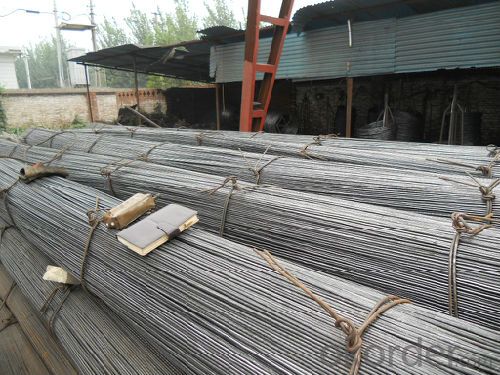
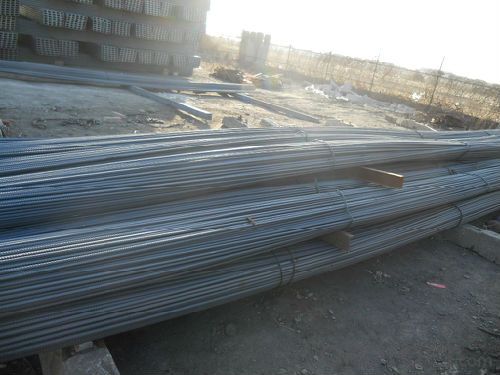

- Q: Are steel rebars susceptible to rust?
- Yes, steel rebars are susceptible to rust.
- Q: How are steel rebars protected from fire during construction?
- Steel rebars are typically protected from fire during construction through the application of fire-resistant coatings or by encasing them in fire-resistant materials, such as concrete. These protective measures help to prevent the steel rebars from reaching temperatures that could compromise their structural integrity in the event of a fire.
- Q: How do steel rebars affect the durability of concrete structures?
- Steel rebars greatly enhance the durability of concrete structures. By reinforcing the concrete, rebars improve its tensile strength, preventing cracking and enhancing its ability to withstand external forces and loads. This reinforcement also helps to increase the overall lifespan of the structure, making it more resistant to corrosion, fatigue, and other forms of degradation.
- Q: What is the corrosion resistance of steel rebars?
- The surface of steel rebars forms a protective layer, known as a passive film, which provides excellent corrosion resistance. This film is created when the steel interacts with the surrounding environment. By acting as a barrier, the passive film prevents oxygen and moisture from reaching the steel, thus inhibiting corrosion. There are various factors that contribute to the corrosion resistance of steel rebars. For example, the presence of alloying elements like chromium, nickel, and molybdenum improves the formation and stability of the passive film, making the rebars more resistant to corrosion. Additionally, the composition and microstructure of the steel rebars play a crucial role in determining their resistance to corrosion. However, it is important to note that the corrosion resistance of steel rebars can be compromised under certain conditions. High levels of chlorides, such as those in marine environments or de-icing salts, can accelerate corrosion and reduce the effectiveness of the passive film. Similarly, exposure to acidic or alkaline environments can also negatively affect the corrosion resistance of steel rebars. To minimize the risk of corrosion, various protective measures can be taken. These include applying coatings or paints to the rebars, using corrosion inhibitors, or implementing cathodic protection systems. Regular inspection, maintenance, and proper design and construction practices are also essential to ensure the long-term corrosion resistance of steel rebars in different applications. In conclusion, the excellent corrosion resistance of steel rebars is due to the formation of a protective passive film. However, this resistance can be influenced by factors such as the environment, alloying elements, and microstructure. By implementing appropriate protective measures and maintenance practices, the corrosion resistance of steel rebars can be effectively maintained, ensuring their durability and structural integrity.
- Q: Can steel rebars be used in residential foundation construction?
- Indeed, residential foundation construction can incorporate steel rebars. These rebars are widely utilized in reinforced concrete structures, including residential foundations, with the intention of bolstering their robustness and longevity. To reinforce and avert cracking or structural collapse, the rebars are typically positioned in a grid formation throughout the foundation. They play a crucial role in evenly distributing the building's load and enhancing its ability to withstand diverse forces, such as soil pressure, wind, and seismic activity. Furthermore, steel rebars possess corrosion resistance and are capable of enduring severe weather conditions, thereby rendering them a dependable option for residential foundation construction.
- Q: How do steel rebars affect the shrinkage and creep of concrete?
- Steel rebars play a significant role in mitigating the shrinkage and creep of concrete. The presence of rebars helps to improve the tensile strength of concrete, which reduces the occurrence of cracking and shrinkage. By providing reinforcement, steel rebars restrict the movement of concrete, minimizing the risk of shrinkage and creep over time.
- Q: What is the process of anchoring steel rebars in masonry walls?
- The process of anchoring steel rebars in masonry walls involves several steps. Firstly, the masonry wall is constructed, leaving gaps or voids where the rebars will be inserted. Secondly, the rebars are cut to the desired length and then inserted into the pre-determined positions in the wall. Next, the rebars are securely anchored or tied to the masonry using various methods such as tying them with wire or using specialized anchoring devices. This ensures that the rebars are firmly embedded within the masonry structure, providing reinforcement and strength to the wall. Finally, the rebars are inspected to ensure they are properly anchored and meet the required specifications and standards.
- Q: What is the role of steel rebars in maintaining structural integrity?
- Steel rebars play a crucial role in maintaining structural integrity by reinforcing and strengthening concrete structures. They provide tensile strength to resist cracking, bending, and shearing forces, enhancing the overall stability and durability of buildings, bridges, and other infrastructure.
- Q: Why can't grounding steel be used?
- When the thread steel is grounded, the contact with the soil is not dense, and the grounding resistance value is increased
- Q: Do steel rebars increase the overall weight of a structure?
- Indeed, the utilization of steel rebars does amplify the overall weight of a structure. Rebars are generally included to fortify concrete structures, offering tensile strength to counterbalance the concrete's vulnerability in managing tension forces. Steel rebars consist of steel, a material that is both dense and weighty. By incorporating rebars into a structure, the weight of these elements contributes to the entirety of the construction's weight. Nevertheless, the supplementary weight is typically insignificant when compared to the overall weight of the structure, especially in extensive ventures. The advantages of employing steel rebars in terms of structural integrity and longevity far surpass the minimal augmentation in weight they contribute.
Send your message to us
Hot Rolled Steel Deformed Bar HRB400 HRB500 HRB600 for construction
- Loading Port:
- Tianjin
- Payment Terms:
- TT or LC
- Min Order Qty:
- 1000 m.t.
- Supply Capability:
- 10000 m.t./month
OKorder Service Pledge
OKorder Financial Service
Similar products
Hot products
Hot Searches
Related keywords
